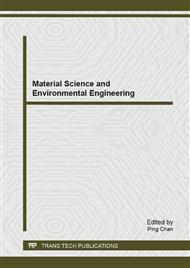p.34
p.41
p.46
p.51
p.58
p.64
p.70
p.74
p.80
Reaction Routes for the Electro-Deoxidation of Ilmenite in Molten Salt
Abstract:
The reaction mechanism of electrochemical extraction of FexTi alloys direct from natural ilmenite in molten CaCl2 has been investigated. The electrochemical deoxidation experiment process was carried out at 1000 °C and 3.8 V, and a solid oxide oxygen-ion-conducting membrane (SOM) filled with carbon-saturated liquid metal was served as the inert anode of the electrolytic cell. The macro-/micro-structure variations of the samples during electrolysis were investigated. The reaction routes from natural ilmenite to FexTi alloys are proposed and discussed. It is found that element Fe is reduced firstly from ilmenite and thus serves as electronic conductor to accelerate subsequent deoxidation, FexTi alloys can be produced directly from natural ilmenite by electrolysis in molten salt. It is suggested that FexTi phase can be formed directly from FexTiOy compounds and/or from deoxidation-generated Ti and Fe through various reaction routes.
Info:
Periodical:
Pages:
58-63
Citation:
Online since:
May 2014
Authors:
Keywords:
Price:
Сopyright:
© 2014 Trans Tech Publications Ltd. All Rights Reserved
Share:
Citation:


